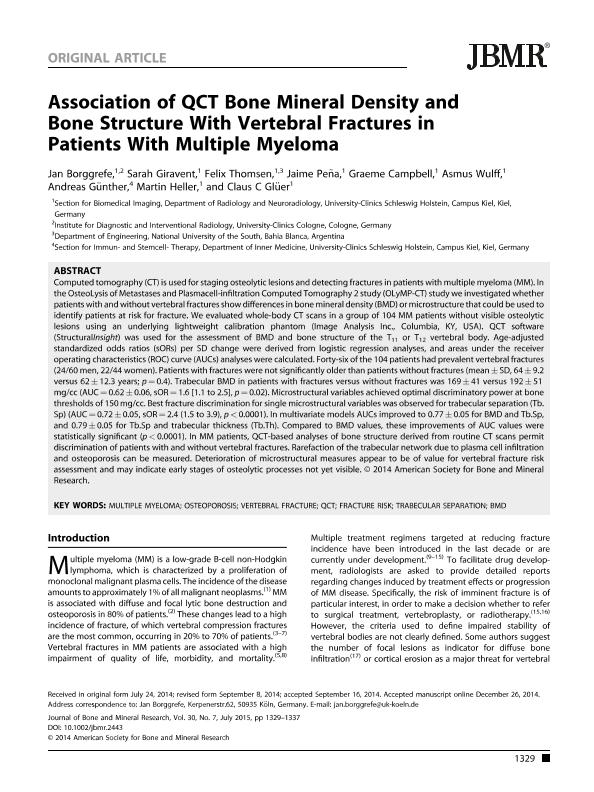Artículo
Association of QCT Bone Mineral Density and Bone Structure With Vertebral Fractures in Patients With Multiple Myeloma
Borggrefe, Jan ; Giravent, Sarah ; Thomsen, Felix Sebastian Leo ; Peña, Jaime ; Campbell, Graeme ; Wulff, A.; Günther, A.; Heller, Martin ; Glüer, Claus C.
; Peña, Jaime ; Campbell, Graeme ; Wulff, A.; Günther, A.; Heller, Martin ; Glüer, Claus C.
 ; Peña, Jaime ; Campbell, Graeme ; Wulff, A.; Günther, A.; Heller, Martin ; Glüer, Claus C.
; Peña, Jaime ; Campbell, Graeme ; Wulff, A.; Günther, A.; Heller, Martin ; Glüer, Claus C.
Fecha de publicación:
07/2015
Editorial:
Wiley
Revista:
Journal Of Bone And Mineral Research
ISSN:
1523-4681
Idioma:
Inglés
Tipo de recurso:
Artículo publicado
Clasificación temática:
Resumen
Purpose: Computed tomography (CT) is used for staging osteolytic lesions and detecting fractures in patients with multiple myeloma (MM). In the OsteoLysis of Metastases and Plasmacell-infiltration Computed Tomography (OLyMP-CT) study we investigated whether patients with and without vertebral fractures show differences in bone mineral density (BMD) or microstructure that could be used to identify patients at risk for fracture. Methods and Materials: We evaluated whole-body CT scans in a group of 104 MM patients without visible osteolytic lesions using an underlying lightweight calibration phantom (Image Analysis Inc., Columbia, KY, USA). QCT software (StructuralInsight) was used for the assessment of BMD and bone structure of the T11 or T12 vertebral body. Age-adjusted standardized odds ratios (sORs) per SD change were derived from logistic regression analyses, and areas under the receiver operating characteristics (ROC) curve (AUCs) analyses were calculated. Results: Forty-six of the 104 patients had prevalent vertebral fractures (24/60 men, 22/44 women). Patients with fractures were not significantly older than patients without fractures (mean ± SD, 64 ± 9.2 versus 62 ± 12.3 years; p = 0.4). Trabecular BMD in patients with fractures versus without fractures was 169 ± 41 versus 192 ± 51 mg/cc (AUC = 0.62 ± 0.06, sOR = 1.6 [1.1 to 2.5], p = 0.02). Microstructural variables achieved optimal discriminatory power at bone thresholds of 150 mg/cc. Best fracture discrimination for single microstructural variables was observed for trabecular separation (Tb.Sp) (AUC = 0.72 ± 0.05, sOR = 2.4 (1.5 to 3.9), p < 0.0001). In multivariate models AUCs improved to 0.77 ± 0.05 for BMD and Tb.Sp, and 0.79 ± 0.05 for Tb.Sp and trabecular thickness (Tb.Th). Compared to BMD values, these improvements of AUC values were statistically significant (p < 0.0001). Conclusion: In MM patients, QCT-based analyses of bone structure derived from routine CT scans permit discrimination of patients with and without vertebral fractures. Rarefaction of the trabecular network due to plasma cell infiltration and osteoporosis can be measured. Deterioration of microstructural measures appear to be of value for vertebral fracture risk assessment and may indicate early stages of osteolytic processes not yet visible.
Archivos asociados
Licencia
Identificadores
Colecciones
Articulos(IIIE)
Articulos de INST.DE INVEST.EN ING.ELECTRICA "A.DESAGES"
Articulos de INST.DE INVEST.EN ING.ELECTRICA "A.DESAGES"
Citación
Borggrefe, Jan ; Giravent, Sarah ; Thomsen, Felix Sebastian Leo; Peña, Jaime ; Campbell, Graeme ; et al.; Association of QCT Bone Mineral Density and Bone Structure With Vertebral Fractures in Patients With Multiple Myeloma; Wiley; Journal Of Bone And Mineral Research; 30; 7; 7-2015; 1329-1337
Compartir



